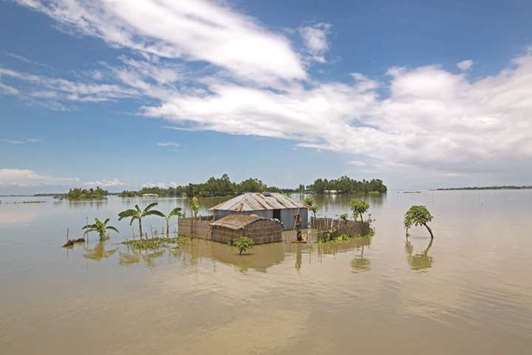When monsoon rains swept Bangladesh last autumn, flooding forced people from their homes in droves. With some scientists estimating that shifting weather patterns could cost the country almost a quarter of its existing landmass, climate migration is fast becoming alarmingly commonplace.
Last September, the Bangladeshi government responded to weeks of torrential rain with a slew of statistics. They said 8mn people in 32 districts had been affected by floods, with 307,000 people staying in emergency shelters and 1,945 medical teams deployed. In addition, 103,855 houses had been destroyed, with a further 633,792 partially damaged, and 4,636 schools – and several hundred thousand acres of farm land – had been flooded.
Saber Saladas and his family were the human face of the government’s dry statistics. They had lived as fishers and farmers for generations on the southwest coast of Bangladesh, near Cox’s Bazar, but in recent years had struggled to adapt to increasingly strong storms and coastal erosion. Other families had moved to the city as saltwater encroached on their rice fields, but they had clung on.
The monsoon floods were severe in 2017, but it was steady, incremental sea-level rise, which sent brackish water further into Saladas’s village than ever before, that finally forced the family to move. With water ankle deep in the family home – their well contaminated, their rice crop failing and no other land to go to – they bowed to the inevitable and left their village, possibly for ever.
“God knows what will happen. We know the end is coming,” says Saladas, in a makeshift shelter on the side of a road near Cox’s Bazar.
Three hundred and fifty miles away, on the other side of the Bay of Bengal at the edge of the Sunderbans mangrove forests, Gopal Munda (left), from Kara Mura district, is preparing to move as his crops fail.
“Once, this village was green with paddy fields. But now the water is salty and the trees have died. We can only farm shrimp. I am devastated when I think that I will have to move,” he says to researchers from the Environmental Justice Foundation (EJF).
Both families are now climate migrants. Saladas expects to go to Chittagong, where many people from his village have gone, and Munda is likely to move to Dhaka.
An Environmental Justice Foundation (EJF) report says that tens of thousands of Bangladeshi families face becoming refugees in their own land.
“Ever more frequent storms, river erosion and salinity intrusion are forcing people from their homes and destroying their lands. And as with so many of the effects of climate change we are seeing today, this is just the start of something far larger,” says the report.
Dhaka and other large cities are already home to a growing number of environmental refugees. “We lost everything to river erosion. We escaped with just our lives,” says Renu Bibi, an 80-year-old woman now living in a slum in the Mirpur district of Dhaka. “Today, boats pass over the place where our land was. Sometimes three or four entire villages will be destroyed.”
Ruma Begum, from Mehendiganj, was forced to move to Dhaka with her family and now lives in Mirpur. “There were between 100 and 150 families along the riverbank. All their homes were washed away. We lost everything,” she says.
The EJF report says the number of people living in slums has increased by more than 60% in the past 17 years in Bangladesh. “Many of the new arrivals are ‘climate refugees’ – people forced to leave their homes due to extreme weather events related to climate change,” it adds.
No one knows exactly how many Bangladeshis are forced to move each year by temporary flooding caused by extreme storms, or by permanent flooding caused by a rise in sea level. But it could be up to 250,000 people a year, says the EJF.
Linking migration directly to climate change is difficult, say academics, because people move for many reasons. But Bangladesh, officially, expects 25-30mn people to move within the next 50 years, or nearly one in six of its present population.
“We are a state that is greatly threatened by the impacts of climate change,” says Munir Muniruzzaman, chair of the Global Military Advisory Council on Climate Change and a former military adviser to the president of Bangladesh. “It has been estimated by the UN IPCC’s reports and analysis that 1m sea-level rise in the south of the country will entail a 17-20% loss of territory to the sea, meaning that Bangladesh will lose up to 20% of its current landmass.”
He warns that the country will be unable to cope. “The internal capacity of the state, given its size and resources, to absorb such a large displacement of the human population and large number of climate refugees, certainly does not exist in the country. Therefore, we are not only going to see internal destabilisation due to large-scale displacement of people, but there will be transboundary migration of climate refugees into the neighbouring countries,” says Muniruzzaman.
But environmental migrants are not recognised as refugees and have none of the legal protections guaranteed by the UN’s 1951 Refugee Convention. This, says the EJF, needs to be addressed urgently.
According to the World Health Organisation, global climate change could contribute to an extra 250,000 deaths worldwide a year between 2030 and 2050, as warmer temperatures lead to more malaria, dengue fever and diarrhoea.
The EJF and others are now pressing for a new UN agreement that would force countries to recognise people displaced by deteriorating environmental conditions linked with climate change. Only legally distinct protection like that conferred on refugees fleeing persecution can effectively address the scale of the problem now growing in places like Bangladesh, it says.

A house sinks into the water in Lalmonirhat, Bangladesh, where flooding triggered by torrential rains has displaced hundreds of thousands of people.


